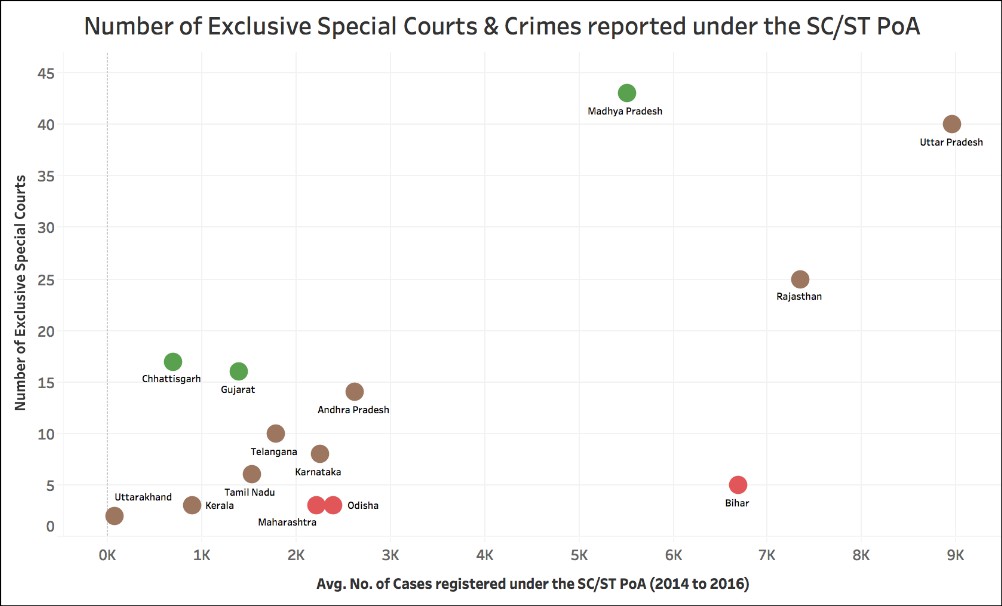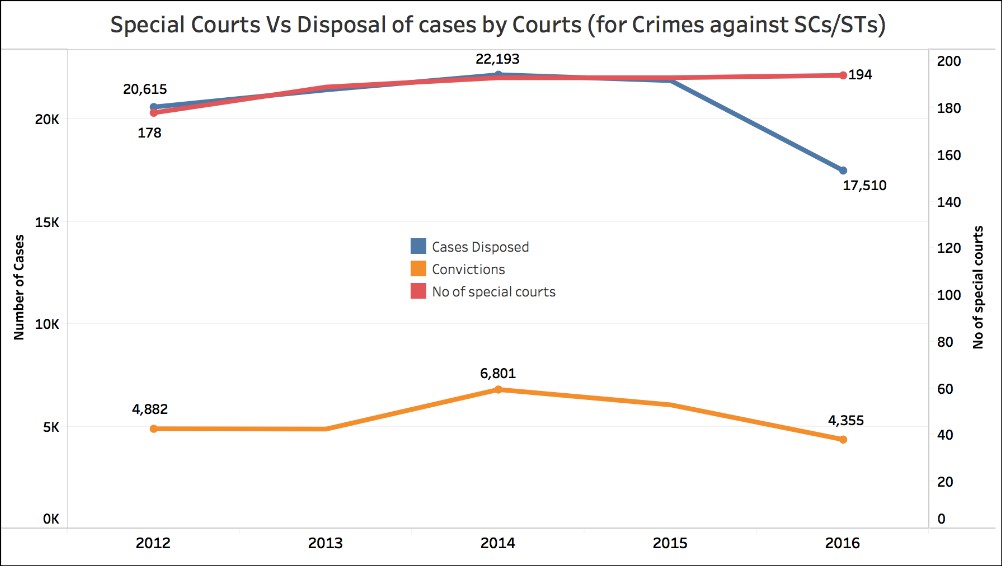[orc]One of the infographics released by the NDA government on the occasion of 48 months in office talks about the strongest amendments to SC/ST PoA. What is the story of this amendment? Have the amendments worked on ground?
One of the infographics that is being circulated by the NDA government as a part of its “48 months of transforming India” campaign is the following about amendments made to the SC/ST Prevention of Atrocities Act. Here is a look at the status of implementation of these amendments and if they have resulted in any visible change.
Amendments to the SC/ST PoA
The SC/ST Prevention of Atrocities Act (PoA) was enacted in 1989 to protect people belonging to the Scheduled Castes (SCs) and Scheduled Tribes (STs). These groups are more vulnerable to discrimination, violence and abuse due to the social position that has been ascribed to them. The state recognizes that, and tried to make amends for it, with the implementation of this Act.
What the NDA government is claiming with this infographic is that under their rule, there have been certain amendments made to the PoA which has further strengthened it. Implicitly they are claiming that their government has made strong efforts towards social justice and the upliftment of the oppressed communities. In particular, the amendments that they claim to have introduced include
- Establishment of exclusive special courts for trying offences under this act
- Outlining the ‘Rights of Victims and Witnesses’
- Defining the responsibilities of the state towards the victims, defendants and witnesses.
The act the infographic refers to is the 2015 Amendment Act which was introduced in the Lok Sabha the year 2014. However, this bill was introduced to replace the presidential ordinance issued in March 2014 towards the fag end of the UPA-II. The three provisions that are outlined in the infographic were previously part of this ordinance. Before the ordinance was to lapse, the bill was introduced in the Lok Sabha.
Thus, although it was under the NDA government that the bill with these amendments was passed, the bill was first introduced by the UPA government. This weakens the claim that this government alone has made significant efforts for social justice. To better understand NDA’s work in the implementation of these amendments, here is an analysis of the implementation of these amendments, especially the special courts and their functioning. It also has to be noted that it is the State Government that has to setup these special courts.
Where are special courts located?
The amendment made to the act envisages the establishment of exclusive special courts to deal with offences committed under this act. The effectiveness of these courts depends on whether they are located in areas where they will be of great use. Ideally, states that have a higher incidence of these crimes should also have a higher number of special courts, in order to ensure there are adequate resources to dispose of these cases. In fact, the amendment envisages setting up of these exclusive courts in districts where there is high incidence of such crimes.
If the number of exclusive special courts setup under this act (as per the 2017-18 annual report of the Ministry of Social Justice) is plotted against the average number of crimes reported under the PoA (between 2014 and 2016), there is a relatively linear relationship, with a few outliers. States that have high incidence of crimes reported under the PoA also tend to have higher number of special courts, and those with lower incidents have less number of special courts. This is also supported by the correlation estimate of 0.68 between these two variables . Thus, it seems that there is a relatively strong relationship between the incidents of PoA and the number of special courts in a state. However, there are certain outliers like Bihar, Maharashtra & Odisha that do not have proportional number of exclusive special courts compared to the incidence of crimes. It has to be noted that data is available only for these 14 states in the annual report of the Ministry of Social Justice.
| State | Number of Exclusive Special Courts | Avg. No. of Cases registered under the SC/ST PoA (2014 to 2016) |
|---|---|---|
| Andhra Pradesh | 14 | 2623 |
| Bihar | 5 | 6687 |
| Chhattisgarh | 17 | 689 |
| Gujarat | 16 | 1393 |
| Karnataka | 8 | 2248 |
| Kerala | 3 | 895 |
| Madhya Pradesh | 43 | 5507 |
| Maharashtra | 3 | 2217 |
| Odisha | 3 | 2394 |
| Rajasthan | 25 | 7355 |
| Tamil Nadu | 6 | 1528 |
| Telangana | 10 | 1781 |
| Uttar Pradesh | 40 | 8961 |
| Uttarakhand | 2 | 72 |

Who is in power in these States?
Another determinant of whether special courts are set up or not is the government within the state since the responsibility of setting up these courts is with the respective state government though special financial assistance is provided by the centre. The states that are under BJP rule have been highlighted in orange. There are a total of 436 districts in these 14 states where as only 195 exclusive special courts are setup. In other words, these courts cover only 44% of the districts. In the BJP ruled states, the exclusive special courts cover 49% of the districts where as in states ruled by others, this is only at 34%. Andhra Pradesh & Telangana are the only states which setup these courts in all the districts. (The data is available only up to 2016-17 post which the number of districts in Telangana has gone up to 31)
What is the efficiency of these Courts?
With more special courts, the number of cases that go to trial are meant to increase along with the number of cases that are ultimately disposed. Hence, another way to understand the impact of the Bill is to see whether the increase in the number of special courts has led to an actual increase in the number of cases disposed of by the courts.
| Year | No of special courts | Convictions | Cases Disposed |
|---|---|---|---|
| 2012 | 178 | 4882 | 20615 |
| 2013 | 189 | 4868 | 21453 |
| 2014 | 193 | 6801 | 22193 |
| 2015 | 193 | 6,051 | 21906 |
| 2016 | 194 | 4,355 | 17510 |
The number of special courts (including exclusive special courts) was the highest in 2016. Despite this, the disposal of cases for crimes against SCs/STs was the lowest in 2016. There was more than a 20% drop in the number of cases disposed by courts in the year 2016 compared to 2015.
Claim Check
While it is true that the NDA government passed the act with these three amendments, these were originally contemplated by the UPA government and an ordinance was issued during the fag end of UPA II. The numbers from the year 2016 also make it clear that the mere amendment to the law has not worked. Hence the claim that NDA alone made strong efforts is only partly true.
This story is part of a larger series on the 4-years of the Modi government. This series has been made possible with the flash grant of the International Fact Checking Network (IFCN). Read the rest of the stories in this series here.


